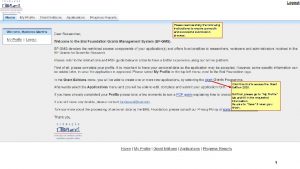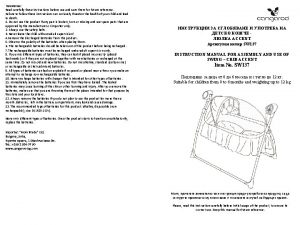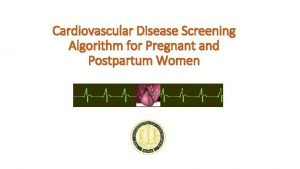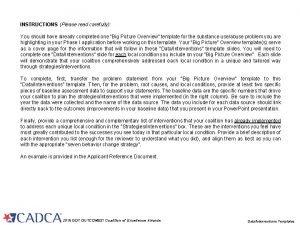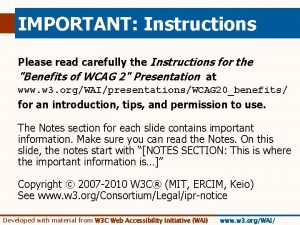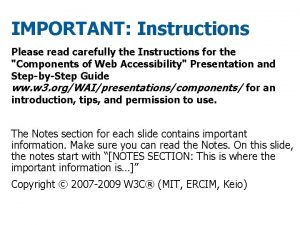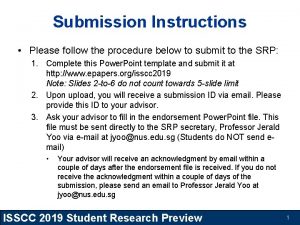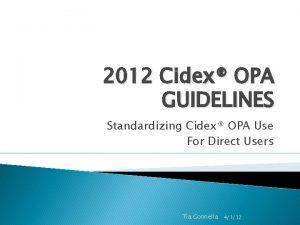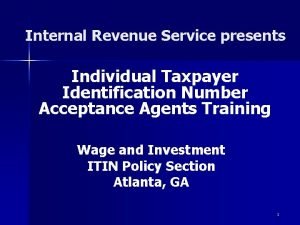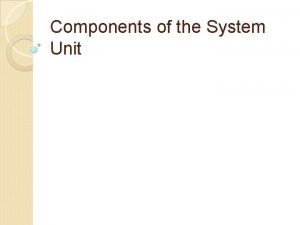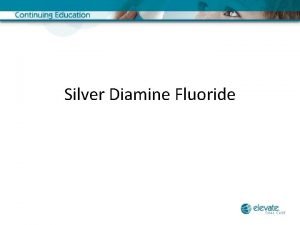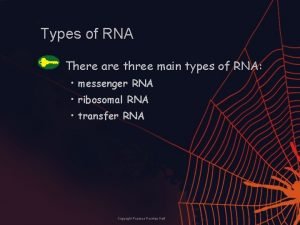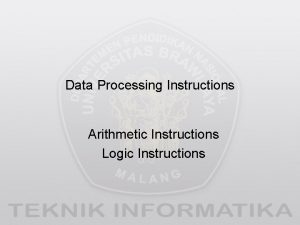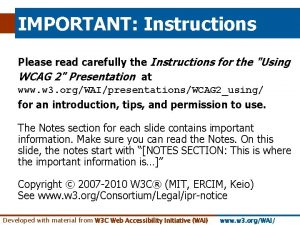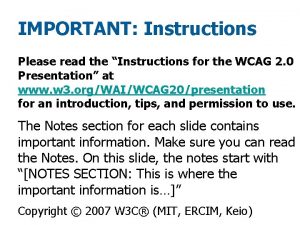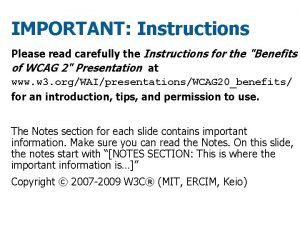Instructions n n n Please use the CMQCC









































































- Slides: 73

Instructions: n n n Please use the CMQCC template for any slide you use from the slide deck Please do not use the CMQCC logo if you modify a slide – feel free to use your own logo in these situations Slides with copyright material that we do not yet have copyright permission to use should not be shared with others (these slides are marked) If you add slides to the slide set please do not use the CMQCC logo Please provide us feedback and recommendations for improving the slide set 1

Generic Slide 2

Improving Health Care Response to Preeclampsia: A California Quality Improvement Toolkit Funding for the development of this toolkit was provided by: Federal Title V block grant funding from the California Department of Public Health; Maternal, Child and Adolescent Health Division and Stanford University. 3

Preeclampsia Task Force Members Maurice Druzin, MD – Stanford Larry Shields, MD – Dignity Health Elliott Main, MD – CMQCC Barbara Murphy, RN – CMQCC Tom Archer, MD – UCSD Ocean Berg, RN, CNS – SF General Hospital Brenda Chagolla, RNC, CNS – UC Davis Holly Champagne, RNC, CNS – Kaiser Meredith Drews – Preeclampsia Foundation Racine Edwards-Silva, MD – UCLA Olive View Kristi Gabel, RNC CNS – RPPC Sacramento Thomas Kelly, MD – UCSD Nancy Peterson, RNC, PNNP – CMQCC Christine Morton, Ph. D – CMQCC Sarah Kilpatrick, MD – Cedars Sinai Richard Lee, MD – Univ. of Southern California Audrey Lyndon Ph. D, RNC – UC San Francisco Mark Meyer, MD – Kaiser SD Valerie Cape – CMQCC Eleni Tsigas – Preeclampsia Foundation Linda Walsh, Ph. D, CNM – UC San Francisco Mark Zakowski, MD – Cedars Sinai Connie Mitchell, MD, MPH – CDPH - MCAH Development of the California Toolkit ‘Improving Health Care Response to Preeclampsia’ was funded by the California Department of Public Health (CDPH), Center for Family Health, Maternal Child and Adolescent Health (MCAH) Division, using federal Title V MCH funds. 4

Maternal Deaths per 100, 000 Live Births Maternal Mortality Rate, California Residents; 1970 -2010 ICD-8 codes ICD-9 codes ICD-10 codes HP Objectives – Maternal Deaths (<42 days postpartum) per 100, 000 Live Births SOURCE: State of California, Department of Public Health, California Birth and Death Statistical Master Files, 1970 -2010. Maternal mortality for California (deaths ≤ 42 days postpartum) was calculated using the ICD-8 cause of death classification for 1970 -1978, ICD-9 classification for 1979 -1998 and ICD-10 classification for 1999 -2010. Healthy People Objectives: HP 2000: 5. 0 deaths per 100, 000 live births; HP 2010: 3. 3 deaths, later revised to 4. 3 deaths per 100, 000 live births, and; HP 2020: 11. 4 deaths per 100, 000 live births. Produced by California Department of Public Health, Center for Family Health, Maternal, Child and Adolescent Health Division, December, 2012. 5

California Pregnancy-Associated Mortality Review (CA-PAMR) Quality Improvement Review Cycle 1. Identification of cases 5. Evaluation and Toolkits 2. Information collection, Implementation of QI review by multidisciplinary Developed: strategies and tools committee • Hemorrhage • Preeclampsia 4. Strategies to improve care and reduce morbidity and mortality 3. Cause of Death, Contributing Factors and Quality Improvement (QI) Opportunities identified 6

CA-PAMR: Chance to Alter Outcome Grouped Cause of Death; 2002 -2004 (N=145) Grouped Cause of Death Chance to Alter Outcome Strong / Some Good (%) None (%) Total N (%) Obstetric hemorrhage 69 25 6 16 (11) Deep vein thrombosis/ pulmonary embolism 53 40 7 15 (10) Sepsis/infection 50 40 10 10 (7) Preeclampsia/eclampsia 50 50 0 25 (17) Cardiomyopathy and other cardiovascular causes 25 61 14 28 (19) Cerebral vascular accident 22 0 78 9 (6) Amniotic fluid embolism 0 87 13 15 (10) All other causes of death 46 46 8 26 (18) Total (%) 40 48 12 145 7

Executive Summary: Hypertension in Pregnancy American College of Obstetricians and Gynecologists Obstet Gynecol 2013; 122: 1122 -31 8

Diagnosis Criteria for Preeclampsia Executive Summary: Hypertension in Pregnancy, American College of Obstetricians and Gynecologist, Obstet Gynecol 2013; 122: 1122 -31. Copyright permission received. 9

Diagnosis of Severe Preeclampsia Executive Summary: Hypertension in Pregnancy, American College of Obstetricians and Gynecologist, Obstet Gynecol 2013; 122: 1122 -31. Copyright permission received. 10

However… • Acute onset, persistent (lasting 15 min or more), severe systolic (≥ 160 mm Hg) or severe diastolic hypertension (≥ 110 mm Hg) or both in pregnant or postpartum women with preeclampsia/eclampsia constitutes a hypertensive emergency* and it is inadvisable to wait 4 hrs for treatment. • If BP is still elevated above threshold after 15 min, treat with antihypertensive medication within 30 -60 min. *Emergent Therapy for Acute-Onset, Severe Hypertension With Preeclampsia or Eclampsia, ACOG Committee Opinion, # 514, December 2011 11

Hemolysis, Elevated Liver Enzymes, and Low Platelets Syndrome (HELLP) and Eclampsia n Women with severe preeclampsia and hepatic involvement may develop HELLP syndrome. In one study, HELLP syndrome occurred in approximately 20% of women with severe preeclampsia. n As with severe preeclampsia, HELLP syndrome is associated with an increased risk of adverse outcomes including: placental abruption, renal failure, subcapsular hepatic hematoma, recurrent preeclampsia, preterm delivery, and fetal or maternal death. n Eclampsia – Seizures with preeclampsia. ACOG Practice Bulletin #33, Reaffirmed 2012; ACOG Committee Opinion #514, 2012; Tuffnell D, Jankowitcz D, Lindow S, et al. BJOG 2005; 112: 875 -880. 12

The Deadly Triad Severe Preeclampsia HELLP Syndrome - Eclampsia Associated with an increased risk of adverse outcomes such as: n Placental Abruption n Renal Failure n Subcapsular Hepatic Hematoma n Preterm Delivery n Fetal or Maternal Death n Recurrent Preeclampsia ACOG Practice Bulletin #33, Reaffirmed 2012; ACOG Committee Opinion #514, 2012; Tuffnell D, Jankowitcz D, Lindow S, et al. BJOG 2005; 112: 875 -880. 13

Spectrum of Preeclampsia CHTN Gestational Hypertension Superimposed Preeclampsia Proteinuria Preeclampsia Eclampsia Atypical Preeclampsia RCVS PRES Severe Preeclampsia HELLP Syndrome 14

Key Clinical Pearl Forty percent of patients with New-onset hypertension or New-onset proteinuria will develop classic preeclampsia. Barton JR, Sibai BM. Prediction and prevention of recurrent preeclampsia. Obstet Gynecol. 2008; 112(2 PART 1): 359 -372. 15

Key Clinical Pearl Patients presenting with vague symptoms of: ¨ ¨ ¨ headache abdominal pain shortness of breath generalized swelling complaints of “I just don’t feel right” should be evaluated for atypical presentations of preeclampsia or “severe features” Sibai BM, Stella CL. Diagnosis and management of atypical preeclampsia-eclampsia. Am J Obstet Gynecol. May 2009; 200(5): 481 e 481 -487. 16

Laboratory Evaluation of Preeclampsia n Initial lab studies should include: ¨ CBC with platelet count ¨ AST, ALT, LDH ¨ Creatinine, Bilirubin, Uric acid, Glucose n For women with acute abdominal pain, add: ¨ Serum amylase, lipase and ammonia 17

ACOG Executive Summary on Hypertension In Pregnancy, Nov 2013 1. The term “mild” preeclampsia is discouraged for clinical classification. The recommended terminology is: a. “preeclampsia without severe features” (mild) b. “preeclampsia with severe features” (severe) 2. Proteinuria is not a requirement to diagnose preeclampsia with new onset hypertension. 3. The total amount of proteinuria > 5 g in 24 hours has been eliminated from the diagnosis of severe preeclampsia. 4. Early treatment of severe hypertension is mandatory at the threshold levels of 160 mm Hg systolic or 110 mm Hg diastolic. 5. Magnesium sulfate for seizure prophylaxis is indicated for severe preeclampsia and should not be administered universally for preeclampsia without severe features (mild). 18

ACOG Executive Summary on Hypertension In Pregnancy, Nov 2013 6. Preeclampsia with onset prior to 34 weeks is most often severe and should be managed at a facility with appropriate resources for management of serious maternal and neonatal complications. 7. Induction of labor at 37 weeks is indicated for preeclampsia and gestational hypertension. 8. The postpartum period is potentially dangerous. Patient education for early detection during and after pregnancy is important. 9. Long-term health effects should be discussed. 19

Maternal Morbidity and Mortality: Preeclampsia About 8 Preeclampsia Related Mortalities/2007 in CA Near Misses: 380/year (ICU admissions) 40 -50 x 400 -500 x Serious Morbidity: 3400/year (prolonged postpartum length of stay) Source: 2007 All-California Rapid Cycle Maternal/Infant Database for CA Births: CMQCC 20

CA-PAMR Causes of Death (Top 5), 2002 -2004 Grouped Cause of Death, per CA-PAMR Committee Pregnancy-Related Deaths N (%) Cardiovascular disease 29 (20) Cardiomyopathy 19 (13) Other cardiovascular 10 (7) Preeclampsia/eclampsia 25 (17) Obstetric hemorrhage 16 (11) Amniotic fluid embolism 15 (10) DVT/ PE 15 (10) Other 45 (31) TOTAL 145 Pregnancy-Related Mortality Rate: 1. 6 deaths /100, 000 live births 21

Maternal Hypertension in California, 1999 -2005 All maternal hypertension identified at time of hospitalization for labor and delivery (includes pre-gestational and gestational hypertension) Source: http: //www. cdph. ca. gov/programs/mcah/Documents/MO-CAPAMRTrendsin. Maternal. Morbidityin. California-1999 -2005 -Technical. Report. pdf 22

Impact of Hypertension in CA-PAMR Cohort, 2002 -2004 n Cohort of pregnancy-related deaths, N=145 ¨ 25 (17%) of deaths were grouped as “Preeclampsia/Eclampsia” cause of death n Over half of all pregnancy-related deaths had HTN diagnoses ¨ 50 (34%) had inpatient diagnosis of HTN ¨ 57 (39%) had any diagnosis of HTN (inpatient, prenatal, preexisting) 23

How Do Women Die Of Preeclampsia in CA? CA-PAMR Final Cause of Death Among Preeclampsia Cases, 2002 -2004 (n=25) Final Cause of Death Number % Stroke Hemorrhagic Thrombotic 16 14 2 Hepatic (liver) Failure 4 16. 0% Cardiac Failure 2 8. 0% Hemorrhage/DIC 1 4. 0% Multi-organ failure ARDS 1 1 4. 0% 64. 0% (87. 5%) (12. 5%) Rate/100, 000 1. 0 . 25 24

Cause of U. S. Maternal Mortality n n n CDC Review of 14 years of coded data: 1979 -1992 4024 maternal deaths 790 (19. 6%) from preeclampsia 90% of CVA were from hemorrhage Mac. Kay AP, Berg CJ, Atrash HK. Obstetrics and Gynecology 2001; 97: 533 -538 25

Key Clinical Pearl Controlling blood pressure is the optimal intervention to prevent deaths due to stroke in women with preeclampsia. Over the last decade, the UK has focused QI efforts on aggressive treatment of both systolic and diastolic blood pressure and has demonstrated a reduction in deaths. 26

Preeclampsia Mortality Rates in California and UK Cause of Death among Preeclampsia Cases CA-PAMR (2002 -04) Rate/100, 000 Live Births UK CMACE (2003 -05) Rate/100, 000 Live Births Stroke 1. 0 . 47 Pulmonary/Respiratory . 06 . 00 Hepatic . 25 . 19 OVERALL 1. 6 . 66 The overall mortality rate for preeclampsia in California is greater than 2 times that of the UK, largely due to differences in deaths caused by stroke. 27

Gestational Age Groups of CA-PAMR Deaths, 2002 to 2004 GESTATIONAL AGE GROUPS 2002 -2004 CA-CA CA-PAMR PREECLAMPSIA DEATHS (N=25) N (%) <24 weeks 0 (0) 24 -31 w 6 d 2 (8%) 32 -36 w 6 d 12 (48%) CA-PAMR NON-PREECLAMPSIA DEATHS N (%) 2 (2%) 13 (11%) -- 56% Early Preterm Birth 11 Preeclampsia Deaths: >37 weeks (44%) 36% (n=9) were <34 weeks gestation TOTAL 25 29 (24%) --37% 76 (63%) 120 28

Expectant Management of Pregnancies with Preeclampsia < 34 Weeks Gestation Maternal Stabilization refers to: Seizure prophylaxis § BP control § Adequate maternal cardio-pulmonary function § § AND § Consultation with: § NICU § MFM § Anesthesia and/or § Critical care services 29

Expectant Management in Pregnancies with Severe Preeclampsia < 34 Weeks Gestation Expectant management recommendations: With stable maternal/fetal conditions, continued pregnancy should be undertaken only at facilities with adequate maternal and neonatal intensive care resources Administer corticosteroids for fetal lung maturity benefit ACOG Executive Summary: Hypertension in Pregnancy. Obstet Gynecol 2013; 122: 1122 -31 30

Key Clinical Pearl In patients with severe preterm preeclampsia, the disease can rapidly progress to significant maternal morbidity and/or mortality. 31

Management of Suspected Severe Preeclampsia < 34 Weeks Gestation No contraindications to expectant management – Short Term Initial 24 -48 hours observation • • • Initiate antenatal corticosteroids if not previously administered Initiate 24 hour urine monitoring as appropriate Ongoing assessment of maternal symptoms, BP, urine output Daily lab evaluation (minimum) for HELLP and renal function May observe on an antepartum ward after initial evaluation Proceed to delivery for: • Recurrent severe hypertension despite therapy • Other contraindications to expectant management Antenatal corticosteroid treatment completed: • Expectant management not contraindicated • Consider ongoing in-patient expectant management Adapted from Sibai BM. Evaluation and management of severe preeclampsia before 34 weeks’ gestation. American Journal of Obstetrics & Gynecology, September 2011, pg. 191 -198. 32

Expectant Management of Pregnancies < 34 Weeks Gestation(From CMQCC Preeclampsia Toolkit, 2013) 33

Management of Suspected Severe Preeclampsia < 34 Weeks Gestation Long Term Management Consider ongoing, inpatient expectant management: • Monitor vital signs frequently (at least each shift) • At least daily maternal assessment for subjective symptoms of severe preeclampsia • At least daily assessment of fetal well-being • Serial evaluation for HELLP syndrome and of renal function • Serial estimation of fetal growth and amniotic fluid volume Adapted from Sibai BM. Evaluation and management of severe preeclampsia before 34 weeks’ gestation. American Journal of Obstetrics & Gynecology, September 2011, pg. 191 -198. 34

Management of Suspected Severe Preeclampsia < 34 Weeks Gestation Long Term Management n • • Proceed to delivery at 34 weeks gestation or earlier if any of the following are present: New-onset contraindications to expectant management (see slide 32) Recurrent symptoms of severe preeclampsia Recurrent severe hypertension despite therapy HELLP syndrome Significant renal dysfunction Abruptio placentae Fetal growth restriction, oligohydramnios, or abnormal fetal testing Adapted from Sibai BM. Evaluation and management of severe preeclampsia before 34 weeks’ gestation. American Journal of Obstetrics & Gynecology, September 2011, pg. 191 -198. 35

Key Clinical Pearl All patients with severe preeclampsia, irrespective of gestational age, should have an evaluation by an obstetrician as soon possible. 36

Factors Associated with Maternal Morbidities in both Developing and Developed Countries n Lack of and/or poor prenatal care Delay in early diagnosis and treatment ¨ Progression to severe eclampsia ¨ n Lack of access to hospital care Lack of access to transportation to clinic ¨ Lack of transport from clinic to hospital ¨ Lack of transport from hospital to tertiary facility ¨ n n Lack of well-trained staff and personnel Lack of proper resources ¨ Medications, Equipment, Laboratory and ICU Magnitude may differ, but the QI issues are similar Ghulmiyyah L, Sabai BM. Maternal Mortality from Preeclampsia/Eclampsia. Semin Perinatol 2012; 36: 56 -59. 37

Factors Contributing to Pregnancy. Related Deaths, CA-PAMR 2002 -2004 Contributing Factor Preeclampsia TOTAL N (%) OVERALL 25 (100%) 129 (89%) PATIENT FACTORS 16 (64%) 104 (72%) (at least one factor probably or definitely contributed) Underlying significant medical conditions 8 (50%) 40 (39%) Delay or failure to seek care 10 (63%) 27 (26%) Lack of understanding the importance of a health event 9 (56%) 16 (15%) HEALTHCARE PROFESSIONALS 24 (96%) 115 (79%) Delay in diagnosis 22 (92%) 62 (54%) Use of ineffective treatment 19 (79%) 48 (42%) Misdiagnosis 13 (54%) 36 (31%) Failure to refer or seek consultation 6 (25%) 26 (23%) HEALTHCARE FACILITY 12 (48%) 72 (50%) 38

Key Clinical Pearl An organized tool to identify “clinical signs, ” of high concern or triggers can aid clinicians to recognize and respond in a more timely manner to avoid delays in diagnosis and treatment. 39

Preeclampsia Early Recognition Tool 40

Clinical Signs to Watch for: 10. 30. 13 v 1 41

Eclampsia n Eclampsia is defined as NEW ONSET grand mal seizures in a woman with preeclampsia n Incidence is 1 in 1, 000 deliveries in U. S. n Mortality from eclampsia ranges from approximately 1% in the developed world, to as high as 15% in the developing world Ghulmiyyah L, Sabai BM. Maternal Mortality from Preeclampsia/Eclampsia. Semin Perinatol 2012; 36: 56 -59. 42

Characterization of Symptoms Immediately Preceding Eclampsia n n 3, 267 deliveries and 46 cases of eclampsia (1. 4%) Most common prodromal neurological symptoms (regardless of the degree of hypertension OR whether the seizure occurred antepartum or postpartum): ¨ Headaches (80%) ¨ Visual disturbance (45%), n 20% of women with eclampsia reported no neurologic symptoms before the seizure Cooray SD, Edmonds SM, Tong S, et al. Characterization of Symptoms Immediately Preceding Eclampsia. Obstetrics & Gynecology, Vol 118(5): 1000 -1004, November 2011. 43

PREECLAMPSIA TOOLKIT TREATMENT RECOMMENDATIONS 44

Preeclampsia Toolkit BP Treatment Recommendations Systolic ≥ 160 Diastolic ≥ 110 Repeat BP and treat within 60 minutes (ideally ASAP) ≥ 155 ≥ 105 -110 Alternative triggers* These recommendations apply to all forms of hypertension in pregnancy: Gestational HTN - Preeclampsia - Severe Preeclampsia * Based on Martin 2005: Martin J, Thigpen B, Moore R, et al. Stroke and severe preeclampsia and eclampsia: a paradigm shift focusing on systolic blood pressure. Obstet Gynecol 2005; 105(2): 246 -254. 45

Reaffirmed 2012 46

Preventing Stroke from Preeclampsia Blood Pressure Comparisons: Baseline and Pre-stroke Measure Pregnancy Baseline (mm Hg) Pre-stroke (mm Hg) Mean systolic BP 110. 9 + 10. 7 (n=25) 175. 4 + 9. 7 (n=24) Systolic BP range 90 -136 159 -198 0 95. 8 (n=27/28) Mean diastolic BP 67. 4 + 6. 5 (n=25) 98. 0 + 9. 0 (n=24) Diastolic BP range 58 -80 81 -113 Diastolic BP % > 110 0 12. 5 (n=3) Diastolic BP 5 > 105 0 20. 8 (n=5) Systolic BP % > 160 Adapted from Martin JN, Thigpen BD, Moore RC, Rose CH, Cushman J, May. Stroke and Severe Preeclampsia and Eclampsia: A Paradigm Shift Focusing on Systolic Blood Pressure, OG 2005; 105 -246. 47

antihypertensive n n n Key Clinical Pearl The critical initial step in decreasing maternal morbidity and mortality is to administer anti-hypertensive medications within 60 minutes of documentation of persistent (retested within 15 minutes) BP ≥ 160 systolic, and/or >105 -110 diastolic. Ideally, antihypertensive medications should be administered as soon as possible, and availability of a “preeclampsia box” will facilitate rapid treatment. In Martin et al. , stroke occurred in: ¨ 23/24 (95. 8%) women with systolic BP > 160 mm Hg ¨ 24/24 (100%) had a BP ≥ 155 mm Hg 3/24 (12. 5%) women with diastolic BP > 110 mm Hg ¨ 5/28 (20. 8%) women with diastolic BP > 105 mm Hg ¨ Martin JN, Thigpen BD, Moore RC, Rose CH, Cushman J, May. Stroke and Severe Preeclampsia and Eclampsia: A Paradigm Shift Focusing on Systolic Blood Pressure, Obstet Gynecol 2005; 105 -246. 48

Labor and Delivery Medication Box and Dose Guidelines for Severe Preeclampsia and Eclampsia 49

Protocol for Labetalol Treatment 50

n IV Labetalol Hypertensive Medication Administration Oral v. IV n ¨ Onset: 2 -5 min ¨ Peak: 5 min n PO Labetalol: ¨ Onset: 20 min-2 hrs ¨ Peak: 1 -4 hrs IV Hydralazine ¨ Onset: 5 -20 min ¨ Peak: 15 -30 min n PO Nifedipine ¨ Onset: 5 -20 min* ¨ Peak: 30 -60 min *PO, (oral) not sublingual nifedipine, onset of action is 15 -30 minutes depending on the reference source. * Cohan J, Checcio L. Nifedipine in the Management of Hypertensive Emergencies: Report of Two Cases and Review of the Literature. 1985 Nov; 3(6): 524 -30 Raheem I, Saiid R, Omar S, et al. Oral nifedipine versus intravenous labetalol for acute blood pressure control in hypertensive emergencies of pregnancy: a randomized trial. BJOG 2012; 119: 78 -85. http: //www. uspharmacist. com/content/d/feature/i/1444/c/27112/ Current Cardiovascular Drugs, edited by William H. Frishman, Angela Cheng-Lai, James Nawarskas, 4 th edition 2005 pg. 2 -186 51

Hypertensive Medication Administration Oral versus IV n n First line therapy recommendations for acute treatment of critically elevated BP in pregnant women (160/105 -110) are with either IV labetalol or hydralazine. In the event that acute treatment is needed in a patient without IV access oral nifedipine may be used (10 mg) and may be repeated in 30 minutes. PO (oral) nifedipine appears equally as efficacious as IV labetalol in correcting severe BP elevations. Oral labetalol would be expected to be less effective in acutely lowering the BP due to its’ slower onset to peak and thus should be used only if nifedipine is not available in a patient without IV access. ACOG Practice Bulletin #33, Reaffirmed 2012; ACOG Committee Opinion #514, 2012; Tuffnell D, Jankowitcz D, Lindow S, et al. BJOG 2005; 112: 875 -880. 52

ACOG Protocol for Hydralazine Treatment 53

Magnesium Sulfate n n n Primary effect is via CNS depression Improves blood flow to CNS via small vessel vasodilation Blood pressure after magnesium infusion: § 6 gm loading then 2 gm/hr. s. BP Mild Group n mm Hg s. BP 30 min 145 ± 10 143 ± 13 s. BP d. BP 120 min mm Hg 30 min 120 min 141 ± 14 87 ± 10 79 ± 9 82 ± 9 Magnesium sulfate should not be considered a antihypertensive medication Belfort M, Allred J, Dildy G. Magnesium sulfate decreases cerebral perfusion pressure in preeclampsia. Hypertens Pregnancy. 2008; 27(4): 315 -27. 54

Magnesium Sulfate in the Management of Preeclampsia Magpie Trial Collaboration Group. Do women with preeclampsia, and their babies, benefit from magnesium sulfate? n n n 58% reduction in seizures 45% reduction in maternal death* 33% reduction in placental abruption *The 45% reduction in maternal death is not statistically significant but clinically important. Altman D, Carroli G, Duley L, et al. The Magpie Trial: a randomized placebo-controlled trial; Lancet 2002; 359: 1877– 90. 55

Recommendations for Women Who Should Be Treated With Magnesium Preeclampsia Severe Preeclampsia Eclampsia ** X X NICE SOGC X* X X CMQCC X* X X WHO X X X without severe features ACOG **ACOG Executive Summary, 2013: for preeclampsia without severe features, it is suggested that magnesium sulfate not be administered universally for the prevention of eclampsia. * Should be considered: Numbers needed to treat (NNT) = 109 for “mild”, 63 for “severe” 56

Key Clinical Pearl n Magnesium sulfate therapy for seizure prophylaxis should be administered to any patients with: ¨ Severe Preeclampsia ¨ Preeclampsia with “severe features” i. e. , subjective neurological symptoms (headache or blurry vision), abdominal pain, epigastric pain AND ¨ should be considered in patients with mild preeclampsia (preeclampsia without severe features) 57

Key Clinical Pearl Algorithms for acute treatment of severe hypertension and eclampsia should be readily available or preferably posted in all clinical areas that may encounter pregnant women. 58

Timing of Pregnancy-Related Deaths, CA-PAMR, 2002 to 2004 63% Percent Pregnancy-Related Death 70 50 Non-Preeclampsia Deaths (n=129) 89% 60 87% 40 30 17 20 10 7 10 1 1 1 0 0 Percent Preeclampsia Deaths 80 70 1 2 3 4 5 Number of weeks between baby’s birth and maternal death 68% 6+ Preeclampsia Deaths (n=25) 96% 60 88% 50 40 30 20 8% 10 12% 4% 4% 3 4 0 0 1 2 0% 5 Number of weeks between baby's birth and maternal death 4% 6+ 59

Postpartum Case Study n n n n 24 year-old G 2, P 0 -0 -1 -0 @ 39 wks Prenatal course unremarkable, GBS (+) Blood pressure normal throughout prenatal period Presented to the office with complaint of regular uterine contractions Cervical exam: 3 cm dilated BP: 142/95 Urinalysis negative for protein 60

Postpartum Case Study (continued) Status on Admission n n The patient was admitted for spontaneous labor and gestational hypertension On admission to Labor and Delivery ¨ BP 133/74 ¨ Urinalysis negative ¨ Platelet count: 187, 000/unit ¨ AST 14 ¨ ALT 18 ¨ Uric Acid 5. 5 61

Postpartum Case Study (continued) Course in Labor n n BP remained modestly elevated throughout labor and the postpartum stay Fetal heart rate consistently Category 1 (normal) tracing Patient had primary late term c/section for failure to progress on day 2 Postpartum course was unremarkable. No documented complaints of headache, blurred vision or epigastric pain 62

Postpartum Case Study (continued) Post-op Day # 3 n n n Patient complained of “acute, crushing headache”, pain rated 8/10. D/C orders already written Received hydrocodone 15 mg/acetaminophen 650 mg Discharged 30 minutes later; no follow-up of headache documented 63

Postpartum Case Study (continued) Post Discharge n n n n Post-op day #4: Patient reported worsening headache to family Post-op day #5: Progressively worsening headache and new-onset visual changes 911 call placed by family Initial seizure occurred shortly thereafter Multiple seizures witnessed by family Intubated in the field and transported to hospital ¨ Started on Mg. SO 4, ativan, keppra, labetalol Helicopter transport to tertiary center, neurology ICU 64

Postpartum Case Study (continued) Post-op Day 6 to 9 n n n Extubated shortly after admission BP’s remained elevated; BP max 148/98; SBP mostly 130’s; DBP mostly 80’s Platelet count 370, 000, AST 30, ALT 33, Creatinine 0. 9 mg/dl Urinalysis: Negative for protein Persistent, mild headache with some postural component ¨ Anesthesia consult obtained; Conservative treatment MRI: “no evidence of ischemic injury”; no parieto-occipital edema suggestive of PRES* *PRES: Posterior Reversible Encephalopathy Syndrome 65

Late Postpartum Eclampsia n n n >48 hours following delivery, up to 4 weeks PP Accounts for approximately 15% of cases of eclampsia 63% had no antepartum hypertensive diagnosis The magnitude of blood pressure elevation does not appear to be predictive of eclampsia The most common presenting symptom was headache, which occurred in about 70% of patients; other prodromal symptoms included shortness of breath, blurry vision, nausea or vomiting, edema, neurological deficit, and epigastric pain Al-Safi Z, Imudia A, Filetti L, et al. Delayed Postpartum Preeclampsia and Eclampsia. Obstet Gynecol. 2011; 118(5): 1102 -1107. 66

Eclampsia: Observations from 67 recent cases n n n 67 cases of eclampsia managed over 4 years 1: 310 deliveries 21% had no proteinuria 21% had no DBP in excess of 90 mm. Hg 37% of first eclamptic seizures occurred postpartum 16% of first eclamptic seizures occurred late postpartum (3 -11 days postpartum) Sibai BM, Mc. Cubbin JH, Anderson GD, et al. Eclampsia. Observations from 67 Recent Cases. Obstet Gynecol; 58: 609, 1981. 67

Eclampsia: Maternal-Perinatal Outcome In 254 Consecutive Cases n n n n 254 consecutive cases of eclampsia over 12 years 83, 720 deliveries, for an incidence of one in 330 49 patients (19%) did not have proteinuria 58 patients (23%) did not have hypertension 73 occurred postpartum, half of which occurred >48 hours after delivery Over half of postpartum cases, (40 cases/16%) occurred in the late postpartum period 18 of these 40 cases were normotensive; all 18 had symptoms of headache or visual disturbance Sibai BM. Eclampsia VI. Maternal-perinatal outcome in 254 consecutive cases. Am J Obstet Gynecol Sep 163(3): 1049 -1054; discussion 1054 -1065 1990. 68

Key Clinical Pearls n n Early post-discharge follow-up recommended for all patients diagnosed with preeclampsia/eclampsia Preeclampsia Toolkit recommends post-discharge follow-up: ¨ within 3 -7 days if medication was used during labor and delivery OR postpartum ¨ within 7 -14 days if no medication was used n Postpartum patients presenting to the ED with hypertension, preeclampsia or eclampsia should either be assessed by or admitted to an obstetrical service 69

Patient Education Materials This and many other patient education materials can be ordered from www. preeclampsia. or g/market-place 70

Key Clinical Pearls n Use of preeclampsia-specific checklists, team training and communication strategies, and continuous process improvement strategies will likely reduce hypertensive related morbidity. n Use of patient education strategies, targeted to the educational level of the patients, is essential for increasing patient awareness of signs and symptoms of preeclampsia. 71

Getting The Job Done in Your Institution n n n Establish tools / new recommendations Establish champions and collaborators Provide convincing rationale for change Get providers to adopt the changes Provide convincing evidence that the proposed changes in clinical care will improve outcome Distribute the convincing rationale and evidence 72

For More Information and to Download the Toolkit n n Visit our website: www. cmqcc. org Or contact us: info@cmqcc. org Available online at www. cmqcc. org 73
 Please read instructions carefully before use
Please read instructions carefully before use Please read the instructions carefully
Please read the instructions carefully Please read instructions carefully before use
Please read instructions carefully before use Cmqcc maternal data center
Cmqcc maternal data center Cmqcc cardiovascular toolkit
Cmqcc cardiovascular toolkit Please read carefully the instructions
Please read carefully the instructions Please follow the instructions below
Please follow the instructions below Please read carefully the instructions
Please read carefully the instructions Please read carefully the instructions
Please read carefully the instructions Please follow below instructions
Please follow below instructions Will you please be quiet please themes
Will you please be quiet please themes Cidex composition
Cidex composition Nnnqq
Nnnqq Optical discs store items by using microscopic
Optical discs store items by using microscopic Imperatives
Imperatives Please remove before use
Please remove before use Please use the add anchor point tool on a segment of a path
Please use the add anchor point tool on a segment of a path Please feel free to use it
Please feel free to use it Pink dress
Pink dress ưu thế lai là gì
ưu thế lai là gì Tư thế ngồi viết
Tư thế ngồi viết Cái miệng nó xinh thế
Cái miệng nó xinh thế Các châu lục và đại dương trên thế giới
Các châu lục và đại dương trên thế giới Cách giải mật thư tọa độ
Cách giải mật thư tọa độ Bổ thể
Bổ thể Từ ngữ thể hiện lòng nhân hậu
Từ ngữ thể hiện lòng nhân hậu Tư thế ngồi viết
Tư thế ngồi viết Giọng cùng tên là
Giọng cùng tên là Thẻ vin
Thẻ vin Thơ thất ngôn tứ tuyệt đường luật
Thơ thất ngôn tứ tuyệt đường luật Hát lên người ơi
Hát lên người ơi Hươu thường đẻ mỗi lứa mấy con
Hươu thường đẻ mỗi lứa mấy con Diễn thế sinh thái là
Diễn thế sinh thái là Vẽ hình chiếu vuông góc của vật thể sau
Vẽ hình chiếu vuông góc của vật thể sau Công của trọng lực
Công của trọng lực Làm thế nào để 102-1=99
Làm thế nào để 102-1=99 Tỉ lệ cơ thể trẻ em
Tỉ lệ cơ thể trẻ em Lời thề hippocrates
Lời thề hippocrates Vẽ hình chiếu đứng bằng cạnh của vật thể
Vẽ hình chiếu đứng bằng cạnh của vật thể đại từ thay thế
đại từ thay thế Quá trình desamine hóa có thể tạo ra
Quá trình desamine hóa có thể tạo ra Các môn thể thao bắt đầu bằng tiếng bóng
Các môn thể thao bắt đầu bằng tiếng bóng Hình ảnh bộ gõ cơ thể búng tay
Hình ảnh bộ gõ cơ thể búng tay Sự nuôi và dạy con của hổ
Sự nuôi và dạy con của hổ Thế nào là mạng điện lắp đặt kiểu nổi
Thế nào là mạng điện lắp đặt kiểu nổi Dạng đột biến một nhiễm là
Dạng đột biến một nhiễm là Biện pháp chống mỏi cơ
Biện pháp chống mỏi cơ Phản ứng thế ankan
Phản ứng thế ankan Voi kéo gỗ như thế nào
Voi kéo gỗ như thế nào Thiếu nhi thế giới liên hoan
Thiếu nhi thế giới liên hoan Phối cảnh
Phối cảnh điện thế nghỉ
điện thế nghỉ Một số thể thơ truyền thống
Một số thể thơ truyền thống Thế nào là hệ số cao nhất
Thế nào là hệ số cao nhất Trời xanh đây là của chúng ta thể thơ
Trời xanh đây là của chúng ta thể thơ Sơ đồ cơ thể người
Sơ đồ cơ thể người Thế nào là số nguyên tố
Thế nào là số nguyên tố đặc điểm cơ thể của người tối cổ
đặc điểm cơ thể của người tối cổ Các châu lục và đại dương trên thế giới
Các châu lục và đại dương trên thế giới Tư thế worm breton
Tư thế worm breton How you use ict today and how you will use it tomorrow
How you use ict today and how you will use it tomorrow Form 13551 instructions
Form 13551 instructions Privileged instructions
Privileged instructions What is the electronic component that interprets
What is the electronic component that interprets Pchl instruction alters program execution sequence
Pchl instruction alters program execution sequence Final exam instructions
Final exam instructions Genes contain instructions for assembling
Genes contain instructions for assembling Poster making activity instructions
Poster making activity instructions Is spectrum self installation easy
Is spectrum self installation easy Wiaa volleyball score sheet instructions
Wiaa volleyball score sheet instructions Advantage arrest instructions
Advantage arrest instructions What are the three main types of rna
What are the three main types of rna Microprogrammed control unit block diagram
Microprogrammed control unit block diagram

